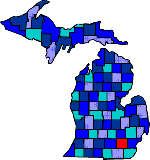

| Size: 716 Square Miles |
| Elevation: 700-1100 Feet |
| Physiography: Rolling plains, hilly uplands, lake-border plains |
| Growing Season: 160-180 days |
| Annual Precipitation: 30-32 inches |
| Average Snowfall: 40 inches |
| Forest Type: Oak-Hickory, Elm-Ash-Cottonwood, Maple-Beech |
| Fall Colors: Middle October |
| In 1680 the French explorer LaSalle came to this area. Then soon after French fur traders and Jesuit Priest came, but none of them stayed permanently. The first trading post was established by the fur traders on the banks of the Huron River in 1809. This area was located on the Pottawatomie Trail (which became Michigan Avenue) what is now known as Ypsilanti. The first settler to Washtenaw county was Major Benjamin Woodruff who bought 60 acres of land in 1823. In 1824 John Allen and Elisha Ramsey started a community, Ann Arbor. In a years time Ann Arbor had 50 settlers. When the University of Michigan was moved from Detroit to Ann Arbor in 1837 the community was on its way becoming a city. In 1839 the railroad connection from Detroit to Ann Arbor increased the growth of the city. Eastern Michigan University was founded in 1852 in Ypsilanti. |
| Ann Arbor | Augusta Township (48160) | Barton Hills (48105) |
| Benton | Bridgewater (48115) | Brookville |
| Chelsea (48118) | Dexter (48130) | Dixboro (48105) |
| Dover (48130) | Eastlawn | Foster |
| Fredonia | Lima | Manchester (48158) |
| Milan (48160) | Paint Creek | Pittsfield |
| Rawsonville | Salem (48175) | Saline (48176) |
| Scio | Sharon Hollow (48158) | Stony Creek |
| Urania | Whitmore Lake (48189) | Whittaker (48190) |
| Willis | Willow Run | Worden |
| York (48160) | Ypsilanti (48197) |
|
Copyright | 2021 | michiganweb.com
|